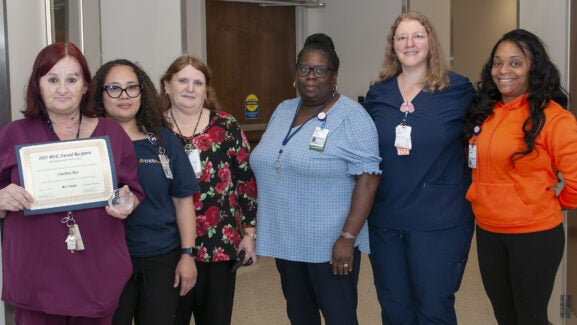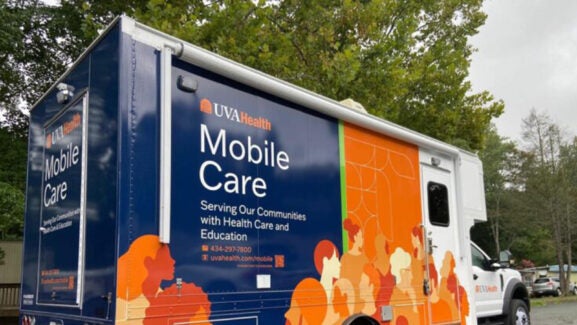
From ‘Best Guess’ to ‘Reboot:’ New Processes Begin to Alleviate Staffing Stressors
The UVA Health Bridge Plan, as its name indicates, is work being done to transform the organization to be nimble and contemporary and to prepare us for long-term strategic planning. The goals are large and lofty, so you may think, “How does this affect me?” Glad you asked, because some of the work has already resulted in real change that team members are experiencing daily.
The Bridge Plan has seven program focus areas, including Workforce and Bed Staffing. Under the Workforce umbrella, one of the projects is aiming to improve inpatient nurse staffing.
“Our objective is to better manage staffing in order to meet the needs of our patients, team members, and community,” says Mike Marquardt, Chief Financial Officer.
Currently, staffing on inpatient units varies widely and is based on differing theories. For example, nursing education can vary from 2% of total worked hours on one unit to over 14% on another.
“Our current process is not standardized,” says Felisha Tyree, RN, Nurse Manager, Labor & Delivery. “It is based on your best guess, your best judgment. There is a lack of standardization right now to help decision-making.”
Getting staffing levels right is critical to safety, patient care, team member well-being, and budgeting. The Workforce project team set out to standardize staffing plans to help nurse managers staff their units more efficiently and effectively.
Once the work began, the team, which includes members of leadership, front-line nursing leaders, and consultants, agreed that the ideal staffing model would have these things in common: accountability, process standardization, common language, transparency, and stewardship.
The end result of the work was the creation of staffing grids and a productivity tracker. Instead of requiring nurse managers to make a best guess, they can use the tools to make accurate, data-driven staffing decisions. The tools use past experience, nursing expertise, data, and algorithms, and allow nurse managers to track staffing in real-time or pull reports to show staffing trends on their unit over a period.
Wait, What Are Staffing Grids and Productivity Trackers Anyway?
The staffing grids help identify the number of team members that are needed on a unit in four-hour blocks. Nurse managers, with input from their directors and team members, had the ability to build their staffing plans from the ground up and then compare them against national benchmark data.
“The nursing staffing grids are to ensure we have the appropriate number of trained clinical staff and the right level of skillsets present at all times,” says Tyree. “We are beginning to transition from the staffing grid development to productivity management using a productivity tracker. Having standard expectations will hold us all to the same standard and ensure we are not overstaffing or understaffing.”
The productivity tool is based on the term “labor productivity,” or how much time it takes to provide a service. In the case of inpatient nursing, this could mean how many nurses, patient care technicians, certified nurse assistants, and other team members it takes to care for the patients on any given unit.
Productivity levels are measured in a percentage, where 100% is the goal, and the target range for each unit is 97.5% to 102.5%. That number provides feedback about how close the unit is to hitting the target.
“It is just as important to us to know when units are running significantly under budget as to know when they are over,” says Karin Skeen, Administrator, Children’s Services. “If teams are working harder than intended, we may lose good people. Retaining our quality people is good stewardship.”
From Concept to Reality
Staffing grids, productivity tools, and all the accompanying data is complex, so training began in March to break it all down. During training, nurse managers learned and adopted the system and began to change workplace culture.
“Whether you have been in the role two years, like me, or if you’ve been in the role 20 years, it’s a reboot,” says Tyree. “It’s a start-over, and we’re all on the same level of learning. We are all learning together, and it is stimulating conversation. It is stimulating innovation. On a critical level, we’re thinking through processes that seem equitable. We are all trying to reach the same goal, and we’re going to get there together. That feels good.”
Now that training is complete, nurse managers are ready to introduce their teams to the concepts.
“There is some encouragement felt in having a consistent tool,” says Jenna Van Hoose, RN, Nurse Manager, 8 West Oncology & Stem Cell Transplant. “When we are all speaking the same language, we can be more productive, and we can be stronger. It’s going to make us, as managers and as an organization, more able to manage and oversee the budget as a whole. What will be important is that we share the same message with our front-line team members about how the staffing grids and tools can and will be used.”
So far, it’s been well received.
“As a nurse manager, I am responsible for integrating the theoretical plan with very real scheduling dilemmas, so that’s going to be the art of this,” says Tyree. “I have brought the productivity tool to some of our staff meetings to try to help team members understand why decisions are being made. Understanding the ‘Why?’ is where you are going to get your buy-in. I am transparent [with my team] about how I am being held accountable. I need [the team’s] partnership and help in making sure that we are all in alignment and being good stewards. If I start speaking the language, they start understanding it. I do want to help transition to this language, so that when I’m talking about productivity, they actually understand what I’m saying.”
Providing Top Patient Care
Once the idea of staffing grids and productivity tools become commonplace on units, team members will feel the stabilization and improvement, which will expand to patients.
“On a patient level, we are not going to be talking productivity,” says Tyree. “We’re not going to be using that language, but [patients] are going to feel the effect. They’re going to feel better staffing levels. They’re going to feel like they really are center.”
Tyree, Van Hoose, and the rest of the nurse managers and charge nurses, are helping take the highest concepts of the Bridge Plan and show their teams how these concepts connect back to our north star: the patient.
“Everything we do should be patient-focused and patient-centered,” says Van Hoose. “To have a tool that helps us as leaders advocate with consistency — whether it’s for more FTEs [full-time equivalent] or time for orientation and education — that helps us manage the needs of our teams and, ultimately, our patients.”
The Start of Something New
The tools are currently rolling out in inpatient areas, and soon, the Workforce project team will begin rollout in procedural areas. Over the past several months, staffing grids and productivity have gone from obscure ideas to practical application. Although challenges and adjustments are expected, teams on the front lines are already feeling the positive effects.
“There will be some learning curves, however, I am grateful that we as managers had the opportunity to collaborate and assist in building our staffing plans and budget,” says Van Hoose. “I am looking forward to the implementation.”
For more information on the Bridge Plan and how you will be impacted, talk to your manager, or visit the UVA Health Bridge Plan website.
Latest News






Thank you Jenna & Felisha!